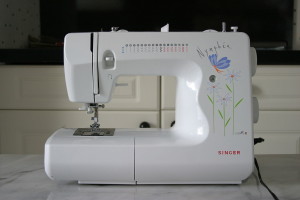
Usually I write about crochet and fiber arts, but I also sew. Making a muslin was one sewing skill I did not bother with until recently. One thing I learned over the years is that I do not fit into a particular size. A muslin helps save me time and a lot of money. Although it takes a little bit of time and effort to create a muslin, once you realize how much money you save in fabric, you will make one for every item you sew.
What is a muslin, you ask. It is a completed or almost completed pattern, traditionally sewn in muslin. Depending where you live, muslin may be hard to find in your local fabric shop or big box retailer. I read a tip online that really helped me. A muslin does not have to be made from muslin, it can be any fabric. With that in mind, the possibilities are endless, but, you want a fabric that is easy to work with. Linens, like bed or large table linens work really well. Sheets, especially queen and king size sheets, are perfect for large sewing projects. Purchasing them new can get expensive, but if you buy them used, at a local thrift shop, the cost is extremely reasonable.
My muslin journey began when I started sewing doll clothes for American Girl and other 18 inch dolls. There are slight differences between each brand of doll. American Girl, Madame Alexander, Gotz, and others are all slightly different. They even differ from doll to doll within the same brand. Creating a muslin allows me to fit the outfit to the doll I am sewing for. It allows me to see if the pattern really works, a lot of the sewing patterns on the internet are full of errors. It is a lot less expensive to find the mistake using inexpensive muslins than using fabric that costs upwards of $10 a yard. A single used sheet will give me plenty of muslins for a doll.
Muslins are used to check the cut and size of a modern pattern. They are also used to make undergarments for historical patterns. Your historical or vintage pattern may not fit right if you wear modern underwear. Depending on the era, women’s undergarments have changed radically. You cut your muslin fabric from the pattern, then you pin it or baste it using the same seam allowances as the pattern. Try on the muslin to check the fit. Make any adjustments buy moving the pins or changing the basting thread. Don’t cut the pattern to make the muslin, just trace it onto the fabric. If you cut the pattern too small, it can be difficult to tape it back to a larger size.
Want to learn more about sewing and creating muslins? Check out Pattern Making Basics, a video class on Craftsy. This is where I started learning to improve my sewing skills. It is a really comprehensive class and if you want to up your sewing game, this is the way to go.